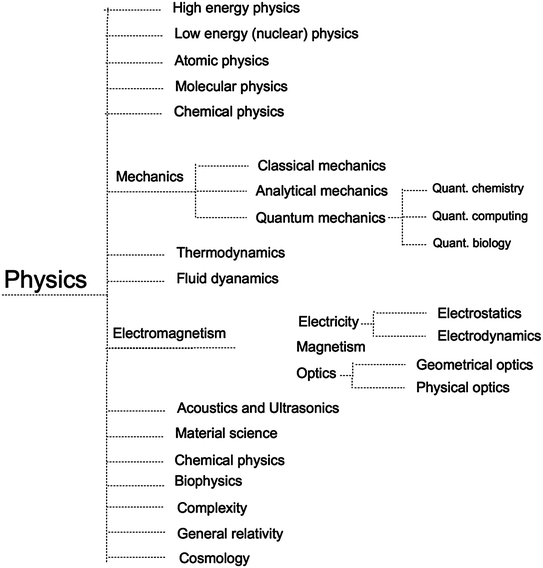1.1 The Beginning
In the beginning was Philosophy, and Philosophy was with Science , and Science was Philosophy . Philosophy shineth in darkness; and the darkness comprehended it not .
But then Philosophy begat children. And the children were many and very successful.
Already in the 6th Century the philosopher Boethius mentioned the three liberal arts of the Trivium , i.e. arithmetic, geometry, music and astronomy . In addition, there were the practical arts, such as medicine and architecture. Later came the division into subjects or disciplines as we know them today, such as physics, chemistry , biology , psychology , etc. In the same manner as a most generous mother, Philosophy divested herself of most of her possessions in favour of her children.
Humans, being human, attribute to themselves the mission of trying to understand the nature of the wonderful and complex world in which they happen to live. For such a quest they utilize epistemological tools , which can be either a priori , i.e. within oneself, or a posteriori, i.e. outside oneself. For the sake of an easy classification, we call mathematics the former and science the latter. Mathematics itself is not a science, yet it constitutes an invaluable tool for science, since it provides the means to interpret the reality we observe and a methodology to search for the underlying governing laws (assuming as a working conjecture that such laws exist and are immutable).
1.2 What Is Physics?
Among all scientific disciplines, physics is ideally suited to the task of discovering the laws of nature , since it deals with everything from the smallest particles (electrons or neutrinos ), to the largest known entities (galaxies , clusters of galaxies, or even the universe itself): see Fig.. There is, however, a remarkable region at sizes around 108 m, i.e. at the molecular level, which is predominantly within the domain of chemistry. This does not mean that molecular physics is not relevant for physicists. It is, but at that level, chemical reactions, which are extremely important both from an applicative and a theoretical point of view, are prevalent and they can best be studied with a very different methodology (that of chemistry). In the last few decades, however, the development of applied Quantum Mechanics has allowed the two converging disciplines of physical chemistry and chemical physics to emerge.
Fig. 1.1
The spatial domain of Physics from the so-called Planck length 1.616252 1035 m, below which the concept itself of dimension loses any physical meaning, up to the current estimate of the diameter of the Universe (approximately 13.8 109 l.y.). Selected lengths or distances are reported in logarithmic scale, encompassing more than 60 orders of magnitude. For astronomical distances a more suitable scale in light-years is also reported (1 l.y. = 9.4605284 1015 m). On the right side selected lengths of relevance in Chemistry and Biology are included
Fig. 1.2
The temporal domain of Physics from the Planck time , i.e. the time required for light to travel in vacuo the distance of one Planck length to the currently estimated age of the Universe (13.8 109 years, to be compared with estimates of around 7000 years by ancient biblical scholars). Selected durations in seconds (to the right also in years for longer lasting events) in a logarithmic scale, encompassing more than 60 orders of magnitude
A subfield of chemistry, organic chemistry, has its own basic relevance, since it is a prerequisite to the understanding of life , i.e., to biology (although not to an understanding of how life originated, which still remains a very open question). Life itself appears in a wide variety of forms. In fact an estimated number of 10 million species fill the realms of fauna and flora (in addition to more primitive forms of life), spanning about eight orders of magnitude in their linear dimensions and 24 in their masses (see Fig. ).
To appreciate the range of our task in this book, it may be helpful to look at how the field of physics is subdivided (see Fig. ).
Fig. 1.3
Traditional subfields of Physics. However, due to the ever growing cross-fertilisation among different methodologies and applications, the boundaries among subfields and even between Physics and other disciplines tend to become more and more fuzzy and arbitrary. Also new subfields (or specialties) are continuously being born
Although our goal is declaredly not the history of physics, but rather physics itself, we report in Fig. a, b a concise chronology of some of the most relevant advances, mainly since the advent of classical physics, which we can date to the time of Galileo. This is not to be taken that no physics, nor even no relevant physics, was done before Galileo . As we mentioned before, ancient philosophers were also physicists at heart in their curiosity about nature, and many of them left important contributions, particularly in astronomy . However, Galileo was the first to introduce in a systematic way the scientific methodology of modern science, in opposition to the Ipse dixit ( He said it, so it is so ) attitude of some previous thinkers, and to pure logical deduction, without reference to facts.
















